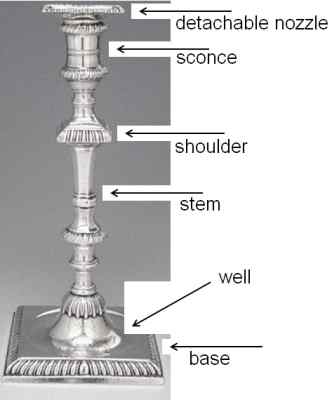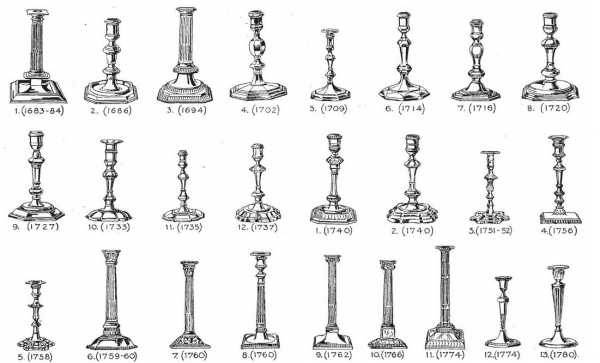(click on photos to enlarge image)
BRITISH CAST CANDLESTICKS
A PIECE OF BEAUTY AND A CHALLENGE FOR COLLECTORS
Introduction
In order to facilitate the lecture of this article, the
following figure identifies the different parts of a candlestick.
A brief history
The use of candlesticks is
documented since the antique Greek period and the
Roman Empire. Candlesticks have been produced in all
periods but it is just after the restoration of
monarchy (1660) that in England survived a
sufficient number of pieces to allow scholars to
describe in details their evolution in style and
shape.
During Charles II period (around 1670) candlesticks
were generally made of hammered silver. They were
highly ornate and with a square base, but lobed
section base examples are also known (Figure 1).
Plainer designs with fluted stem of square section
are also documented at this time. At the end of XVII
century candlesticks had lobed or octagonal (usually
square with cut corners) base with gadroon
decoration and lobed stem (Figure 2).
The history of cast candlesticks in England formally
begins with the introduction of the Britannia
standard for silver wrought plate (end of XVII
century) that attracted the attention of the
craftsman to cast work, the softer metal not lending
itself to the hammer.
|
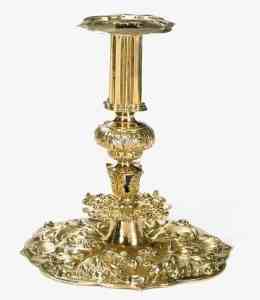 |
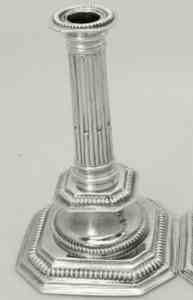 |
.
|
Figure 1 - A Charles II
hammered candlestick
with lobed section. London 1665 Jacob Bodendick
|
Figure 2 - A William III
candlestick. This model is usually
light and with a pick filled stem. London 1698
Richard Syng
|
Cast candlesticks were generally produced by soldering
different parts, individually obtained by casting: the base; the
stem, casted in two separated part and then soldering the two
halves; and, occasionally, the sconces. Nozzles, if there are,
were the only part produced by hammering or by combine hammering
and casting.
The evolution of the crafting technique is summarized in the
following scheme, where dates should be intended as indicative
and the crafting technique as the prevalent one also referring
to the single item.
It must be noted that cast candlesticks were also produced,
mainly as reproduction of antique items, in the Victorian era
and during the XX century. Furthermore demi-figure and figure
candlesticks have been produced by casting at any age.
Evolution of cast candlesticks in style and shape
Cast candlesticks were
generally shorter and heavier than the hammered ones.
Their size and weight varied considerably during
time. From 1700 to 1735 candlestick were about 15-18
cm tall. From 1735 to 1760 they were 19-23 cm tall,
to reach 14-28 cm in the late examples (around 1775
- 1780).
Weight was always high, ranging from 600-900 g per
pair for the shortest and to 900 - 1,350 g or more
per pair for the tallest ones.
Their shape had much in common with the contemporary
standing cups. In the very early examples (around
1685) the surface of silver was left very plain to
allow the light from the candle to be reflected.
They had lobed base or square with cut corners and
baluster vase-shaped stem (Figure 3). Lobed and
gadroon decoration, both on stem and base, appeared
around 1690, the base being square with cut corners,
or occasionally round (Figure 4).
|
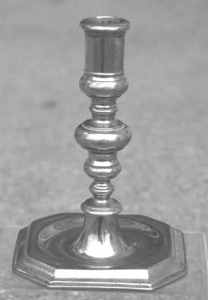 |
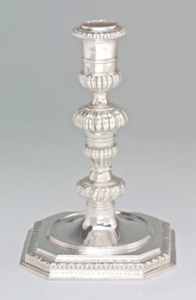 |
.
|
Figure 3 - A very early
plane design cast
candlestick.
London 1690
|
Figure 4 - Cast
candlestick with lobed and
gadrooned decoration.
London 1692 Pierre Harache
|
In the Queen Anne period
(1702-1714) the stem can be found of octagonal shape,
on round base in early examples (Figure 5), and on
octagonal base from 1710 on.
The latter are considered the most desirable of the
period, mainly in the variant with diamond facets
(Figure 6).
Their surface was usually plain with the only
possible addition of an engraved coat of arm.
|
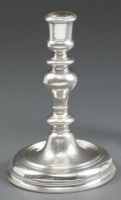 |
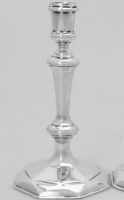
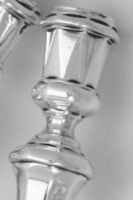 |
.
|
Figure 5 - An early Queen
Anne
round base cast
candlestick.
London 1705 Andrew Raven
|
Figure 6 - A Queen Anne
octagonal base and shape cast candlestick
with diamond facets
London 1712 and detail of stem
and sconce
|
In the George I period
(1714-1727) the shape seems to come back to that in
use in the early Queen Anne period, but with heavier
examples with more steps in the base.
The base can be square with cut corners (Figure 7),
or with cut corners ribbed at the center of each
angle (Figure 8).
Very seldom, at this time, can be found candlesticks
with floral decoration and if so they were obtained
from the original casting and then chased.
From 1720 appeared candlesticks with hexagonal base
(also without well).
Stem and sconce are also hexagonal or, occasionally
round (Figure 9).
|
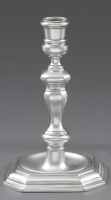 |
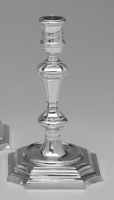 |
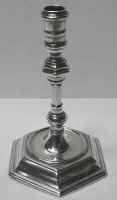 |
.
|
Figure 7 - A typical
George I
cast candlestick.
London 1727 John Le Sage
|
Figure 8 - A George I cast
candlestick with cut corned
ribbed base. London 1722 David Green
|
Figure 9 - A hexagonal
base early
George II cast candlestick.
London 1728
|
From 1730 to at least
1746, a lot of candlestick had square base with cut
corners ribbed at the center of each angle or with
lobed base (Figure 10).
Others, dating 1735, had shaped square base with
stem decorated with bands and ribs.
From this date on the level of decoration increased
(Figure 11 and 12).
In many examples the base is now round with rimmed
decoration and baluster vase-shape decorated stem.
Detachable nozzles seem to appear at this date.
|
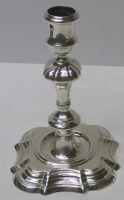 |
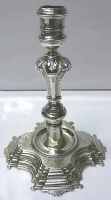 |
 |
.
|
Figure 10 - Cast
candlestick
with lobed base
London 1738 Gabriel Sleath
|
Figure 11 - A beautifully
ornate
cast and chased candlestick
London 1737 Charles Kandler
|
Figure 12 - A more
decorated example
(mainly acanthus leaves) with fluted stem
and nozzle - London 1746 Thomas Gilpin
|
Rococo influence on
candlestick is evident from around 1750 (Figure 13
and 14), although some examples, mainly from very
important makers like Paul de Lamerie, appeared
around 1740.
Whirlpool, non-symmetrical design on both stem and
base and a cartouche, always part of the casting,
are typical features (Figure 15 and 16).
|
 |
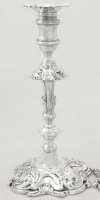 |
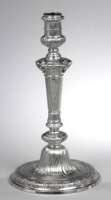 |
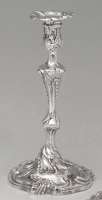 |
.
|
Figure 13 - Another more
decorated example
London 1750 John Cafe
|
Figure 14 - An example
where the
Rococo influence begins to be more
evident - London 1748 William Mackenzie
|
Figure 15 - A Rococo
design
George II cast candlestick
London 1751 Alexander Johnson
|
Figure 16 - A late and
highly ornate example of Rococo cast candlestick -
London 1762 Alexander Johnson
|
In the same period cast
demi-figure (usually half female figure) and figure
candlesticks appeared, someone on the base of very
rare late XVII century examples.
They had irregular shape base and were generally
crafted by casting several independents parts,
soldering them together and then chasing the surface
to give the final touches (Figure 17).
|
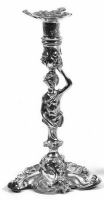 |
.
|
.
|
Figure 17 - A cast
demi-figure
candlesticks - Dublin 1773 John Walker
|
.
|
The most common type of
Georgian (George II and George III period)
candlesticks date around 1750 but was produced with
minor changes till 1770.
They had shaped square base (usually with the well)
decorated with shells at the angles (Figure 18).
A less common variant had a "sexfoil" shell base
(Figure 19).
Occasionally appeared cast and chased examples
(Figure 20).
|
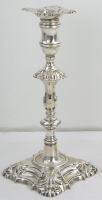 |
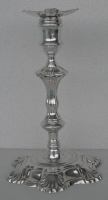 |
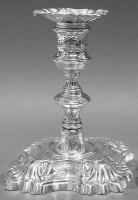 |
.
|
Figure 18 - A typical
George II
cast candlestick with cut corned
ribbed base - London 1755
John Cafe & John Hyatt
|
Figure 19 - A George II "sexfoils"
base variant cast candlestick with
shell decoration at the base
London 1747 Edward Sieber
|
Figure 20 - A typical
George II cast
candlestick with cut corned ribbed
base and cast and chased decoration
London 1755 William Gould
|
Around 1760, the most
popular design provided square base with gadrooned
rim (Figure 21), some examples, dating around 1765,
with swirl fluting decoration at the base of the
stem, repeated on the shoulders and on the
detachable nozzle (Figure 22).
A pair of this type of candlesticks can reach the
weight of 1,800 g.
|
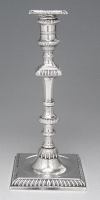 |
 |
.
|
Figure 21 - A square base
cast candlestick with
gadrooned decoration
London 1763 William Cafe
|
Figure 22 - A square base
cast
candlestick with whirlpool
decoration
London 1765 Hannam & Carter
|
Examples having round base and Adam neoclassic motifs and
finished applied decoration are documented at least around 1775.
A very useful picture of the evolution of shape of candlesticks
from the late XVII to the end of XVIII century is done by A. O.
Curle & F. S. A. Scot. The following picture has been
constructed by using images reported in their work. The date
given being those of the earlier hallmarks found applicable to
each shape.
Hallmarks on cast candlesticks
Most XVIII century cast candlesticks are hallmarked
underneath, with one mark (lion passant, leopard head, maker
mark and date letter) at each corner (Figures 23 - 26). Although
the underside of the candlestick was usually left very rough as
a consequence of the process of casting, hallmarks are usually
clear because in this position they are preserved from
cleaning and rubbing.
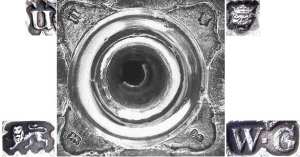 |
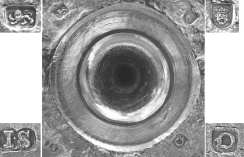 |
Figure 23 - Typical
hallmarks on a XVIII century cast
candlestick. London 1755 William Gould
|
Figure 24 - Typical
hallmarks on a XVIII century cast
candlestick. London 1769 John Scofield
|
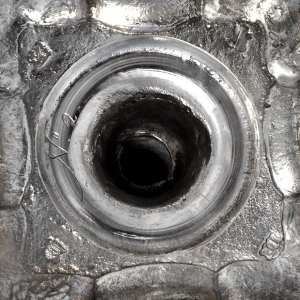 |
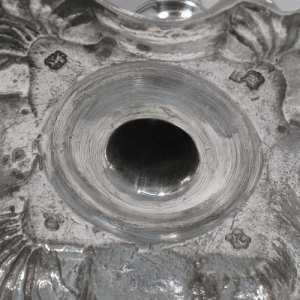 |
Figure 25 - Typical
hallmarks on a XVIII century
cast candlestick. London 1753 J. Priest
|
Figure 26 - Typical
hallmarks on a XVIII century cast
candlestick. London 1754 John Café
|
Early examples of Queen
Anne period are hallmarked underneath with scattered
hallmarks (Figure 27).
|
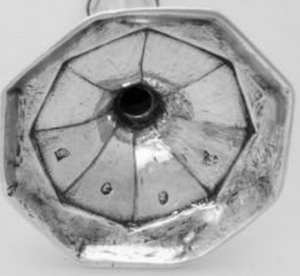 |
Some example of the Queen
Anne period (mainly those of octagonal base with
diamond facets), can be marked around the external
part of the rim of the foot.
In this case hallmarks may be difficult to read
because they are more exposed to cleaning and
rubbing.
Irish examples of this shape (produced up to 1735)
can be found marked on the base, usually in the well,
which represent a typical Irish feature.
Nozzles appeared around 1735 and should bear the
lion passant (Figure 28) or the lion passant and the
maker mark, but they can be occasionally unmarked.
|
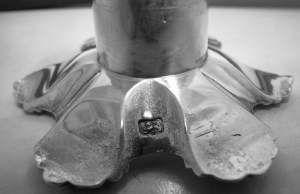 |
.
|
Figure 27 - Scattered
hallmarks struck underneath a Queen Anne period
cast candlestick. London 1712
|
.
|
Figure 28 - Lion passant
struck on a detachable
nozzle of a cast candlestick - London 1757
|
The majority of
candlesticks from 1700 to 1760 (ideally till 1784)
have a lion passant struck on the sconces (not
detachable) or a lion passant and a leopard head
(Figure 29).
Square base or round base candlesticks often bear
grouped hallmarks, struck on the inside rim at one
point (Figures 30 and 31).
|
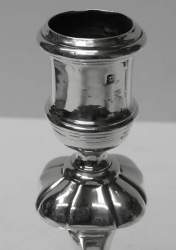 |
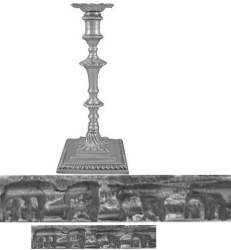 |
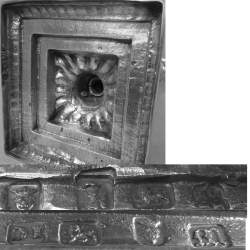 |
.
|
Figure 29 - Lion passant
struck on
the sconce of a cast candlestick
London 1738 Gabriel Sleath
|
Figure 30 - Grouped
hallmarks struck on the
internal part of the rim of a cast candlestick
London 1765
|
Figure 31 - Grouped
hallmarks struck on the
internal part of the rim of a cast candlestick
London 1765-7 Hannam & Carter
|
Fake and genuine reproduction
Cast candlesticks are difficult items to deal with as they
may have been cast from an original, including hallmarks. In the
case of a pair, this can be easily verified by comparing the
position of the hallmarks at the base: if the position is
exactly the same and the marks are of the same dimension, they
are probably a fake. In this case hallmarks should be probably
not clear, mainly in the ground.
As already noted, cast candlesticks have been produced, mainly
as reproduction of antique items, in the Victorian era and
during the XX century. Looking at these candlesticks (Figures 32
– 34) it is usually not possible to realize that they are
reproduction. Only the presence of "modern" hallmarks allows to
classifying them for what they are. In XX century reproduction,
hallmarks are usually struck as in the original example of the
XVIII century (Figures 35 and 36), while reproduction done in
the Victorian period usually bears grouped hallmarks (Figures 37
and 38).
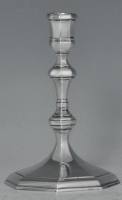 |
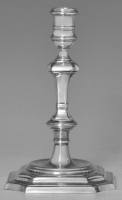 |
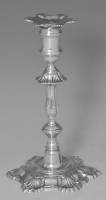 |
Figure 32 - Reproduction
of a
Queen Anne cast candlestick
London 1973 J. C. Lowe
|
Figure 33 - Reproduction
of a
George I/II cast candlestick
London 1977 James Robinson
|
Figure 34 - Reproduction
of a
George II cast candlestick
Birmingham 1982 J. B. Chatterley &
Sons Ltd.
|
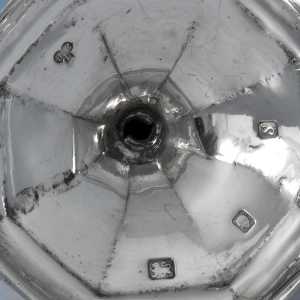 |
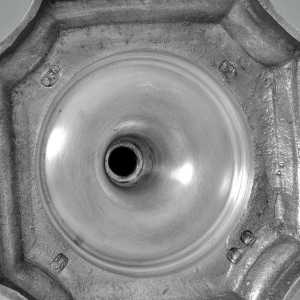 |
Figure 35 – "Modern"
hallmarks underneath a
reproduction of a Queen Anne cast candlestick
London 1973 J. C. Lowe.
Note that hallmarks are correctly struck like
in original model (see Figure 27)
|
Figure 36 – "Modern"
hallmarks underneath a
reproduction of a XVIII century cast candlestick
London 1977 James Robinson. Note the presence
of the optional Queen Elisabeth
jubilee hallmarks near the date letter
|
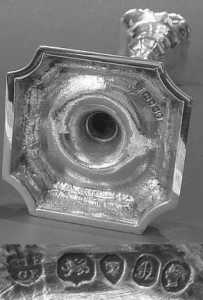 |
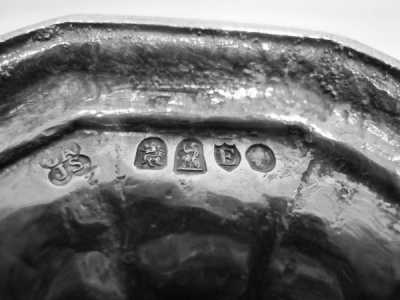 |
Figure 37 – Grouped
hallmarks underneath
a Victorian reproduction of a XVIII cast candlestick
London 1848 Charles and George Fox
|
Figure 38 – Grouped
hallmarks underneath a Victorian reproduction
of a XVIII cast candlestick - London 1880 Aldwinkle
& Slater.
Note that the reproduction was done using the
Britannia standard
|
Some example has been cast
from an earlier one and then re-hallmarked, so
bearing two set of hallmarks. In this case, the
ground of Georgian hallmarks, having come out in the
casting, does have slight pitting and one can
usually detect a later casting. However, as the
underside was usually left very rough, hallmarks may
be badly struck also on genuine items.
The previous examples of hallmarks (Figures 23 - 26)
cannot leave any doubt about the authenticity of the
artifacts, but the situation that may occur can be
more complex to deal with.
Figure 39 shows an example of hallmarks struck on a
genuine XVIII century cast candlestick that, mainly
due to the roughness of the base are not well
impressed and so difficult to judge by a
non-experienced person. Unfortunately is just in
this field that one should pay attention because
cast candlesticks are among the artifacts most
susceptible to forgery.
|
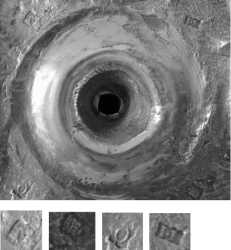 |
.
|
Figure 39 - Hallmarks
badly struck on a
genuine XVII Century cast candlestick
London 1749 John Priest
|
A good work on this subject has been done by J. Audy & E.
Evin in their "Analysis of silver candlesticks from a casting
point of view". Among the cited examples of forgery they
compared the porosity of the underneath surface outside and
inside the hallmarks. Figure 40 clearly shows that the entire
artifact is the results of a casting, including hallmarks, being
similar the ground porosity of both hallmarks and other parts of
the base. This is also evident in the following example drown
from another cast candlestick (Figure 41). The overall surface
roughness is identical to that inside of the hallmarks (compared
with genuine hallmarks in Figure 42), which indicates that they
were produced by casting rather than striking. Their quality is
poor, but not as bad as that observed from the previous
candlestick. In the latter case some doubt can also arise from
the position of the hallmarks, grouped rather than struck one at
each angle of the base, as they can be found on the majority of
contemporary examples.
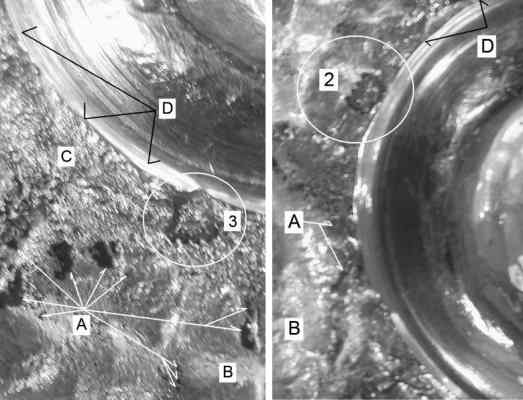 |
Figure 40 - Base of the
"George II era" candlestick - with positions of
hallmarks (a); and
the details (b and c) depicting porosity (A, B, C),
machined surface D, and detailed
images of forged hallmarks (3 - London City, and 2 -
lion) produced by casting instead
of striking (J. Audy & E. Evin, 2010)
|
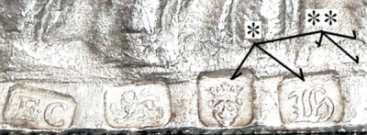 |
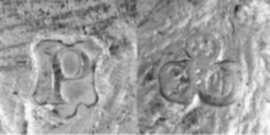 |
Figure 41 - Photographs
showing the set of fake hallmarks on
the "George III era" candlestick, trying to convince
one that the
artifact was made by the silversmith Ebenezer Coker
(E.C)
(J. Audy & E. Evin, 2010)
|
Figure 42 - Genuine
hallmarks struck on a XVIII century
cast candlestick - London 1750 John Cafe. Note that
porosity in the ground of the hallmarks is
considerably
less than in other parts of the base
|
Examples with hallmarks transposed into the base have been
very occasionally documented. In this case, it should be
possible to spot these by breathing on them and looking for any
unnecessary seams. If the sconce is not hallmarked on a
candlestick dating before 1784, one should verify if for a
possible repair or consider a possible replacement.
Images Credit:
Personal collection
Daniel Bexfield Antiques (www.bexfield.co.uk)
James Baldwin Antiques's (www.jamesbaldwinantiques.com)
I.Franks The London silver Vault (www.ifranks.com)
Waxantiques (www.waxantiques.com)
OnlineGalleries (www.onlinegalleries.com)
G Cohen - Fine Antique Silver (www.gcohen.co.uk)
Sanda Lipton Antique Silver (www.antique-silver.com)
Bibliography
Peter Waldrom, 2001. The price guide of antique silver.
Antiques Collector's Club, Woodbridge, Suffolk (UK).
Ian Pickford, 2003. Starting to Collect Antique Silver -
Antiques Collector's Club, Woodbridge, Suffolk (UK).
Alexander O. Curle, F. S. A. Scot. 1926. Domestic candlestick
from the fourteenth to the end of the eighteenth century. ADS
Archaeology Data Service. http://ads.ahds.ac.uk/catalogue/adsdata/arch-352-1/dissemination/pdf/vol_060/60_183_218.pdf
Jaromir Audy and Emil Evin. 2010. An analysis of silver
candlesticks from a casting point of view: originals, copies,
forgeries. China Foundry Vol.7 No.1.
http://www.foundryworld.com/uploadfile/201032959415937.pdf
|





